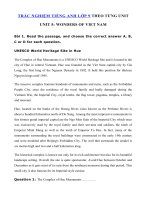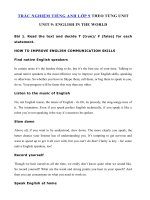Tải Trắc nghiệm Reading tiếng Anh lớp 8 Unit 7 Pollution - Bài tập Tiếng Anh 8 mới theo từng Unit có đáp án
Bạn đang xem bản rút gọn của tài liệu. Xem và tải ngay bản đầy đủ của tài liệu tại đây (96.12 KB, 5 trang )
<span class='text_page_counter'>(1)</span><div class='page_container' data-page=1>
<b>TRẮC NGHIỆM</b>
<b> TIẾNG ANH 8</b>
<b> THEO UNIT</b>
<b>UNIT 7: POLLUTION</b>
<b>Read the passage below and decide whether the statements are TRUE or FALSE?</b>
Light pollution is the excessive, misdirected or invasive use of artificial outdoor lighting.
Mismanaged lighting affects the environment, energy resources, wildlife, humans and
astronomy research.
Light pollution is not a new phenomenon. Over the last 50 years, as countries became
affluent and urbanized, demand for outdoor lighting increased and light pollution
sprawled beyond the city limits and into suburban and rural areas. This form pollution is
now prevalent in Asia, Europe, and North America, particularly in cities like Los
Angeles, New York and Washington D.C. In 2008, National Geographic magazine
named Chicago the most light-polluted city in the United States.
However, the most light-polluted spot in the world is Hong Kong, China. In March 2013,
the University of Hong Kong named the city the most light polluted in the world. A
study by the university found the night sky in Tsim Sha Tsui, an urban neighborhood in
southern Kowloon, Hong Kong, to be 1,200 times brighter than a normal urban city sky.
Luminous pollution of this magnitude is on the rise worldwide. In a 2010 article from the
Ecology and Society Journal, Hölker and others stated the use of artificial lighting
increases by 20% each year, depending on the region, and noted there is an urgent need
for light pollution policies that surpass energy efficiency to include humans, animals and
the environment.
<b>Question 1: Light pollution is the excessive, misdirected or invasive use of artificial</b>
outdoor lighting.
</div>
<span class='text_page_counter'>(2)</span><div class='page_container' data-page=2>
<b>Question 2: Light pollution sprawled beyond the city limits and into suburban and rural</b>
areas.”.
A. True
B. False
<b>Question 3:Chicago is the most light-polluted city in the world.</b>
A. True
B. False
<b>Question 4: A city in Hong Kong is more than two hundred times brighter than a normal</b>
one.
A. True
B. False
<b>Question 5: Luminous pollution of this magnitude is on the rise worldwide.</b>
A. True
B. False
<b>Choose the letter A, B, C or D to complete the passage below</b>
Water pollution happens __________ (6) toxic substances enter water bodies such as
lakes, rivers, oceans and so on, getting dissolved in them, lying suspended in the water or
depositing on the bed. This degrades the quality of water. Not __________ (7) does this
spell disaster for aquatic ecosystems, the pollutants also seep through and reach the
groundwater, which might end up in our households as contaminated water we use in our
daily activities, including drinking.
</div>
<span class='text_page_counter'>(3)</span><div class='page_container' data-page=3>
pollution include contaminants that enter the water supply from soils or groundwater
systems and from the atmosphere via rain. Soils and groundwater contain __________
(10) residue of human agricultural practices and also improperly disposed of industrial
wastes.
Pollutants can be of varying kinds: organic, inorganic, radioactive and so on. In fact, the
list of possible water contaminants is just too vast to be listed here.
<b>Question 6: A. what</b> B. when C. why D. while
<b>Question 7: A. both </b> B. only C. well D. either
<b>Question 8: A. cause </b> B. caused C. causing D. causes
<b>Question 9: A. of </b> B. in C. at D. for
<b>Question</b>
<b>10:</b> A. a B. an C. the D. x
<b>Choose the letter A, B, C or D to answer these following questions</b>
There are many causes that lead to water pollution. One main cause of this issue is waste
water coming from many factories and then being directly pulled out into water bodies,
especially into rivers or seas without any treatment because this is the most convenient
way of disposing waste water. Industrial waste consists of some kinds of chemical
substances such as sulphur, which is harmful for marine life. Lead is known as the main
reason for cancer disease. Cancer has become a popular disease in several communes
which are called “cancer villages”. Another cause is the awareness of citizens, people
always use water for many purposes and then they dump waste water or garbage directly
into rivers, canals and ponds and so on. In 2004, because of a bird flu outbreak in Viet
Nam, people threw poultry to water body that made water highly polluted.
<b>Question 11:How many causes of water pollutions are listed in the passage?</b>
A. one
</div>
<span class='text_page_counter'>(4)</span><div class='page_container' data-page=4>
C. three
D. four
<b>Question 12: Is the sewage from factories treated before dumping into water bodies?</b>
A. Yes, it is
B. No, it isn’t
<b>Question 13: What is the main reason for cancer disease?</b>
A. rice
B. rain
C. lead
D. food
<b>Question 14:What is cancer called when it has become a popular disease in several</b>
communes?
A. cancer grounds
B. cancer offices
C. cancer pollutions
D. cancer villages
<b>Question 15: What did Vietnamese do in 2004?</b>
A. They bought dead poultry.
B. They ate dead poultry.
</div>
<span class='text_page_counter'>(5)</span><div class='page_container' data-page=5>
D. They dig dead poultry under ground
<b>Đáp án</b>
1 - A 2 - A 3 - B 4 - B 5 - A
6 - B 7 - B 8 - B 9 - A 10 - C
11 - B 12 - B 13 - C 14 - D 15 - C
Mời bạn đọc thêm tài liệu Tiếng Anh lớp 8 tại đây:
Bài tập Tiếng Anh lớp 8 theo từng Unit:
Bài tập Tiếng Anh lớp 8 nâng cao:
</div>
<!--links-->









